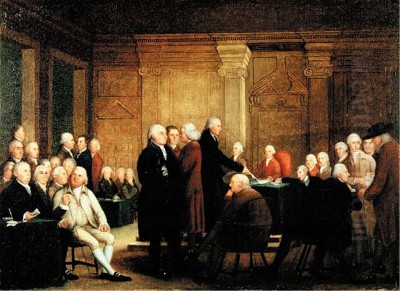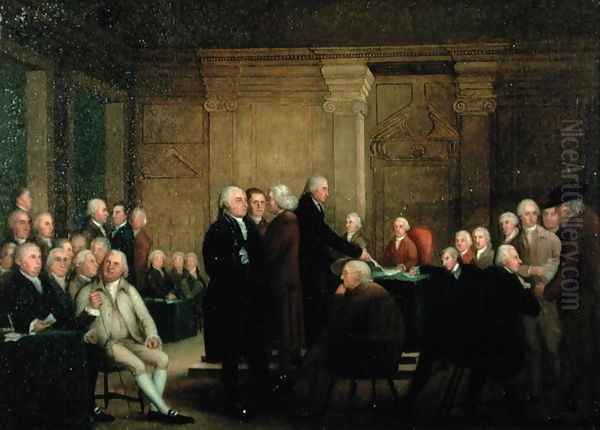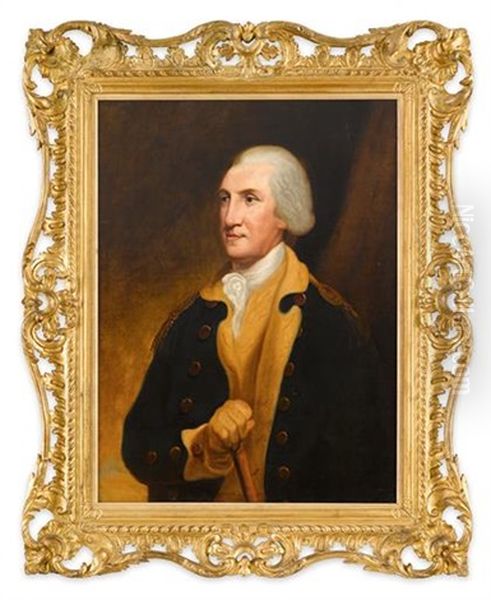
Robert Edge Pine stands as a fascinating, if sometimes overlooked, figure in the annals of eighteenth-century art. An artist whose career bridged the established art world of London and the nascent artistic landscape of a newly independent America, Pine’s work provides a unique lens through which to view the cultural and political currents of his time. Primarily a portraitist and historical painter, his canvases captured the likenesses of theatrical luminaries, British gentry, and the founding fathers of the United States, all while navigating the turbulent tides of revolution and personal conviction.
Early Life and Artistic Genesis in England
Born in London around 1730, Robert Edge Pine was immersed in an artistic environment from his earliest days. His father, John Pine, was a distinguished engraver, illustrator, and a prominent Freemason, known for his meticulous work, including engravings of the Houses of Parliament and his association with the celebrated satirist William Hogarth. This familial connection undoubtedly provided young Robert with an early exposure to artistic techniques and the vibrant, competitive London art scene.
Pine quickly demonstrated his own artistic talents. He began to make a name for himself through participation in public exhibitions, a crucial avenue for artists seeking patronage and recognition in an era before the proliferation of commercial galleries. In 1760, a significant early success came when he was awarded the prestigious first prize gold medal by the Society for the Encouragement of Arts, Manufactures and Commerce (now the Royal Society of Arts) for his historical painting, "The Surrender of Calais to Richard III." This award, for a subject steeped in English history and patriotic sentiment, marked him as a history painter of considerable promise.
Following this initial triumph, Pine became a regular exhibitor in London. From 1760 until 1772, his works were frequently displayed at the Society of Artists and the Free Society of Artists. These institutions were vital platforms, predating the Royal Academy of Arts (founded in 1768), and offered artists like Pine opportunities to showcase their skills in various genres. He continued to garner accolades, further cementing his reputation within the British artistic community.
A Flourishing Career in London: Portraits and History

During his active years in England, particularly between 1760 and 1784, Robert Edge Pine established himself as a proficient portrait painter. He was especially noted for his depictions of contemporary theatrical figures. The London stage was a vibrant hub of culture, and actors and actresses were celebrities in their own right. Pine captured the likeness of the legendary David Garrick, one of the most famous actors of the era, renowned for his Shakespearean roles. Such portraits not only catered to public fascination with the theatre but also demonstrated Pine's ability to convey personality and dramatic presence.
Beyond the stage, Pine also painted portraits of other notable individuals, contributing to the rich tradition of British portraiture dominated by figures like Sir Joshua Reynolds, the first president of the Royal Academy, and Thomas Gainsborough, whose elegant and fluid style offered a contrast to Reynolds's grand manner. While Pine may not have reached the same towering heights of fame as these contemporaries, he carved out a respectable career, known for a certain directness and an ability to capture a sitter's character.
Historical painting remained a significant interest for Pine. Works like "Canute Reproving His Courtiers," based on the apocryphal tale of the Anglo-Scandinavian king demonstrating the limits of earthly power to his flattering courtiers, showcased his ambition to tackle grand themes. These historical compositions often displayed a dramatic flair, influenced perhaps by his engagement with the theatre, and aligned with the academic hierarchy of genres that placed history painting at its apex. Other artists like Benjamin West, an American who found great success in London and became a historical painter to King George III, were also popularizing large-scale historical and mythological scenes during this period.
Political Convictions and the Journey to America
Robert Edge Pine was a man of strong, and at times, outspoken political convictions. He developed a deep sympathy for the cause of American independence, a stance that was not widely popular in many circles in Britain, particularly as tensions escalated into the American Revolutionary War (1775-1783). His Whiggish leanings and vocal support for the American colonists reportedly led to a degree of ostracism within certain segments of the British art establishment and a potential loss of patronage.
This political idealism found expression in his art. Around 1778, he painted an allegorical work titled "America," which depicted America accompanied by figures representing Liberty, Peace, and Prosperity, lamenting the ravages of war but looking towards a brighter future. Such a piece was a bold statement of his political sympathies. Another version, "America's Lamentation on the Horrors of War," further underscored his feelings about the conflict.

By the early 1780s, the combination of his political views, which may have hindered his career prospects in Britain, and a genuine admiration for the new American republic, led him to make a life-altering decision. In 1784, the year after the Treaty of Paris officially ended the Revolutionary War, Robert Edge Pine emigrated to the United States. He was drawn by the promise of a new society founded on principles he admired and the opportunity to chronicle its birth. He settled in Philadelphia, which was then the largest city in the newly independent nation and its temporary capital.
A New Chapter in Philadelphia: Chronicling a New Nation
Upon his arrival in Philadelphia in 1784, Robert Edge Pine embarked on an ambitious new phase of his career. He envisioned creating a series of large-scale historical paintings depicting pivotal moments of the American Revolution. This grand project was fueled by his desire to immortalize the heroes and events of the struggle for independence. He brought with him letters of introduction, including one from the prominent British intellectual and American sympathizer, Dr. Richard Price, to figures like George Washington.
In Philadelphia, Pine quickly set about establishing himself. He began painting portraits of key figures of the Revolution. Among his notable American sitters were George Washington himself, whom he painted at Mount Vernon in 1785. This portrait, later engraved and included in biographies of Washington, aimed to capture the dignity and leadership of the future first president. He also painted other prominent individuals such as Robert Morris, a financier of the Revolution, Francis Hopkinson, a signer of the Declaration of Independence and a designer of the American flag, and Charles Carroll of Carrollton.
Pine's studio in Philadelphia became a hub of artistic activity. His wife, Jane, and their daughters, at least one of whom, also named Jane, was an artist in her own right, assisted him in his work. He also took on pupils, contributing to the development of artistic talent in the young nation by running a painting school. This was a period when American art was still finding its voice, with established figures like Charles Willson Peale, a soldier, naturalist, and prolific portraitist, already active in Philadelphia, and younger talents like Gilbert Stuart and John Trumbull beginning to make their mark, often after seeking training in London with artists like Benjamin West.
One of Pine's significant contributions to the Philadelphia art scene was organizing an exhibition of his own works in 1784 at the State House (Independence Hall). For this exhibition, he published a descriptive text, which is considered one of the earliest, if not the first, exhibition catalogues produced in America. This initiative demonstrated an entrepreneurial spirit and a desire to engage the American public with fine art.
Key American Works and Artistic Aspirations
The centerpiece of Robert Edge Pine’s American ambition was his projected series of historical paintings on the Revolution. While he did not live to complete the entire series, he began work on what was perhaps the most significant of these: "Congress Voting Independence." This painting aimed to depict the members of the Second Continental Congress during the debates and adoption of the Declaration of Independence. Pine undertook considerable research, seeking out life portraits of the signers. He managed to paint many of them from life, a valuable historical record in itself.
The "Congress Voting Independence" was a monumental undertaking. Pine worked on it from 1784 until his death. The painting, left unfinished by Pine, was later completed by the American artist Edward Savage around 1801. Despite its composite nature, it remains an important early visual representation of this seminal moment in American history, predating John Trumbull's more famous "Declaration of Independence" painting. Pine's work, even in its planning stages, shows his commitment to historical accuracy in portraiture within a grand compositional framework.
His allegorical painting "America," which he had conceived in England, also resonated in his new home. It symbolized the ideals and aspirations of the fledgling nation. His interactions with patrons like Samuel Vaughan, a Philadelphia merchant and supporter of the arts, further encouraged his focus on American historical themes. Vaughan, like many others, recognized the importance of visually documenting the birth of their nation for posterity.
Artistic Style and Techniques
Robert Edge Pine's artistic style was rooted in the British academic tradition of the mid-to-late eighteenth century, which emphasized strong drawing, balanced composition, and a certain degree of idealization, particularly in historical subjects. His portraits are generally characterized by a straightforward, unpretentious quality, aiming for a faithful likeness rather than overt flattery. His coloration was often rich, and he demonstrated a competent handling of textures, particularly in fabrics.
In his historical compositions, Pine showed a capacity for dramatic arrangement and narrative clarity. His English works, like "The Surrender of Calais," exhibit a Neoclassical interest in historical accuracy of costume and setting, combined with a dynamic portrayal of human emotion and action that sometimes bordered on the theatrical. This dramatic tendency can also be seen in his planned American historical scenes.
Compared to his more famous British contemporaries, Pine's style might be seen as less polished than Reynolds's or less ethereal than Gainsborough's. However, his work possessed a solidity and earnestness. In America, his style would have been seen as sophisticated, bringing a level of European academic training that was still relatively rare among native-born artists, though figures like John Singleton Copley (who had largely relocated to England by this time) and Benjamin West had already demonstrated American artistic talent on an international stage. Pine's approach to portraiture, while perhaps less psychologically penetrating than that of Gilbert Stuart, who would soon become the preeminent portraitist in America, was nonetheless valued for its verisimilitude.
His technique primarily involved oil on canvas, the standard medium for ambitious portraiture and history painting. The scale of his intended revolutionary scenes suggests a command of large-format composition, a skill honed through his earlier historical works in England.
Challenges, Legacy, and Historical Evaluation
Despite his ambitions and industriousness, Robert Edge Pine faced challenges. His grand series on the American Revolution was never fully realized, partly due to his relatively early death in 1788. Furthermore, while respected, his work did not always achieve the widespread acclaim or financial success that might have been anticipated, particularly in a new nation still developing its infrastructure for artistic patronage. Some contemporary accounts suggest that his direct, sometimes blunt, personality, which had caused friction in England, may have also occasionally complicated his relationships in America.
Historically, Pine's reputation has perhaps been overshadowed by artists who either had longer careers in America, like Charles Willson Peale, or who became more iconic, like Gilbert Stuart with his portraits of Washington. Many of Pine's works, particularly those remaining in England, did not survive, and some were reportedly destroyed in the early 19th century, further complicating a full assessment of his oeuvre.
Nevertheless, Robert Edge Pine's artistic influence and historical importance are undeniable. He was one of the first academically trained British artists to commit his career to the new United States, bringing with him valuable skills and a European perspective. His portraits of the Founding Fathers are significant historical documents. The likenesses he captured of figures like Washington, Morris, and Hopkinson contribute to our visual understanding of these pivotal individuals. His "Congress Voting Independence," even though completed by another hand, remains a key piece of early American historical art.
His role in organizing one of America's first art exhibitions and publishing a catalogue was a pioneering effort in fostering public appreciation for the arts. His teaching, though perhaps limited in scope, also contributed to the growth of an American artistic tradition. Artists like Joseph Wright of Derby in England were exploring new subjects related to science and industry, while Pine, in America, was focused on the equally novel subject of a nation's revolutionary birth.
Personal Life
Robert Edge Pine's personal life was intertwined with his artistic pursuits. He married Jane Holborn in 1749. The couple had several children, reportedly seven in total. As mentioned, his wife and daughters were actively involved in his studio, assisting with the considerable labor involved in producing paintings, from preparing canvases to perhaps even painting drapery or backgrounds, a common practice in artists' studios of the period.
His daughter, Jane Pine (sometimes referred to as Miss Pine), followed in her father's footsteps as a portrait painter. She exhibited her own work and continued to be active after her father's death, indicating a familial dedication to the arts that spanned generations, much like the Peale family in America or the Tischbein family in Germany. This familial support system was crucial for an artist like Pine, especially after his relocation to a new country.
Conclusion: A Transatlantic Legacy
Robert Edge Pine died suddenly in Philadelphia on November 19, 1788, reportedly from apoplexy. He left behind a body of work that, while perhaps not as extensive or widely known as some of his contemporaries like George Romney or Angelica Kauffman in Europe, or later American masters, holds a distinct and important place in the art history of both Britain and the United States.
He was an artist of talent and conviction, whose career reflected the momentous changes of his era. His early successes in London demonstrated his skill in the established genres of portraiture and historical painting. His unwavering support for American independence, however, set him on a unique path, leading him to become an artistic chronicler of a new republic. His portraits preserve the faces of revolutionary leaders, and his historical paintings, though some unfinished, offer valuable early interpretations of America's founding moments. Robert Edge Pine remains a testament to the power of art to engage with history and to the enduring connections between the Old World and the New. His journey and his art provide a compelling narrative of an artist navigating the complex currents of the late eighteenth century with a brush dedicated to both likeness and liberty.